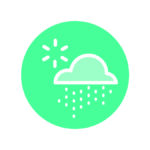How Air & Water Quality Impact Health
Clean air and water are crucial for a community’s health and well-being. Pollutants from industrial emissions, vehicle exhaust, and wildfires significantly degrade air quality, worsening respiratory conditions such as asthma and bronchitis and contributing to cardiovascular problems1. Similarly, contaminated water the risk of gastrointestinal illnesses and neurological disorders due to the presence of harmful pathogens and chemicals. Effective monitoring and regulation to ensure good air and water quality can reduce disease, improve overall wellness, and create healthier living environments.
Indicators on this page:
Air & Water Quality Indicators:
Indicators related to Climate Change:
Air Quality Indicators
Days Meeting Healthy Air Goal
Why this is important: Air quality is affected by smoke, dirt, dust, and soot, known as particle pollution, commonly sourced from wood stoves and fireplaces, construction, agriculture, outdoor burning and wildfires, or industrial facilities. Elevated air pollution has negative health consequences, including asthma, chronic bronchitis, and cardiovascular disease, and increases the risk of premature death in those over age 652. Air pollution is measured in units called micrograms per cubic meter of air, abbreviated as µg/m³. This measurement tells us how many micrograms of pollutants are present in one cubic meter of air.
Definition: Percent of days meeting the 24-hour average healthy air goal of <35 ug/m3 for particulate matter 2.5 microns (or less)

Trend: The percent of days meeting the healthy air goal in Whatcom County has not been changing significantly since 2005.

Geography: Available data for this indicator do not allow for comparisons to Washington State.

Disparities: Available data for this indicator do not allow for visualization or analysis by subpopulation.
Learn more:
- Wildfire Smoke, Whatcom County Health and Community Services.
- Northwest Clean Air Agency
- Particle pollution in Washington’s air, Washington State Department of Ecology.
- Washington’s Air Quality Monitoring Network Map, Washington State Department of Ecology.
Nitrate Exposure
Why this is important: Public water systems serve approximately 90% of the population in Washington State, drawing water from groundwater wells, surface water, or purchasing from other systems. Nitrates, which are water-soluble, can enter these sources both naturally and through human activities such as agriculture and industrial processes. Consuming water with nitrate concentrations exceeding 10 mg/L can pose significant health risks. Maintaining safe nitrate levels helps prevent the adverse health effects associated with excessive exposure and ensures that the public water supply remains safe for consumption.
Definition: Percent of population on Public Water Systems exposed to nitrate exceedances (>10mg/L)

Trend: The percent of the population on Public Water Systems that is exposed to nitrates has not been increasing since 2011.

Geography: Available data for this indicator do not allow for comparisons to Washington State.

Disparities: Available data for this indicator do not allow for visualization or analysis by subpopulation.
Learn more:
- Nitrate in Drinking Water, WA State Department of Health.
- Drinking Water Nitrate and Human Health: An Updated Review, International Journal of Environmental Research and Public Health, 2018.
Indicators Related to Climate Change
Climate change is causing changing weather patterns, more frequent periods of extreme cold and heat, and increased wildfires – all conditions that negatively impact health3. Extreme and prolonged heat and cold can be especially detrimental to the health of vulnerable groups, including the elderly, the very young, and those whose employment requires them to be outdoors. Wildfire smoke and dust exacerbate asthma and other respiratory diseases. These illnesses negatively impact quality of life and place an additional burden on the healthcare system. Monitoring emergency department visits related to these climatic conditions helps us understand how climate change impacts community health.
Asthma-related ED Visits
Why this is important: Asthma-related emergency department visits can be a result of poor air quality, such as smog or particulate matter (dust or smoke). Periods of worsened air quality trigger more frequent and severe asthma attacks, increasing asthma-related emergency department visits4.
Definition: Percent of annual emergency department visits involving asthma

Trend: The percent of annual emergency department visits involving asthma-related illness in Whatcom County has not been changing significantly from 2018 to 2023.

Geography: Available data for this indicator do not allow for comparisons to Washington State.

Disparities: Available data for this indicator do not allow for visualization or analysis by subpopulation.
Learn more:
- Asthma and climate change, Harvard T.H Chan School of Public Health.
- Climate Change and Children’s Health and Well-Being in the United States, US Environmental Protection Agency, 2023.
- Ozone-related asthma emergency department visits in the US in a warming climate, Environmental Research, 2020.
Heat-related ED Visits
Why this is important: Heat-related illnesses, including heatstroke, dehydration, and heat exhaustion, result from exposure to extremely hot weather. Heat-related illness can cause severe symptoms and, in extreme cases, death. As heat waves become more frequent and prolonged, heat-related illnesses prompt more visits to emergency departments5.
Definition: Percent of annual emergency department visits involving heat-related illness

Trend: The percent of annual emergency department visits involving heat-related illness in Whatcom County has not been changing significantly from 2018 to 2023.

Geography: Available data for this indicator do not allow for comparisons to Washington State.

Disparities: Available data for this indicator do not allow for visualization or analysis by subpopulation.
Learn more:
- Heat Stress Data, WA State Department of Health.
- People at Increased Risk for Heat-Related Illness, US Centers for Disease Control and Prevention, 2024.
- Heat Stress – Heat Related Illness, US Centers for Disease Control and Prevention.
- Emergency Department Visits for Heat-Related Emergency Conditions in the United States from 2008–2020, International Journal of Environmental Research and Public Health, 2022.
Cold-related ED Visits
Why this is important: Exposure to extreme and prolonged cold temperatures can exacerbate respiratory conditions and lead to hypothermia and frostbite. These and other cold-related illnesses and injuries cause people to seek medical care in emergency departments.
Definition: Percent of annual emergency department visits involving cold-related illness

Trend: The percent of annual emergency department visits involving cold-related illness in Whatcom County has not been changing significantly from 2018 to 2023.

Geography: Available data for this indicator do not allow for comparisons to Washington State.

Disparities: Available data for this indicator do not allow for visualization or analysis by subpopulation.
Learn more:
- Winter Shelters for Individuals and Families Experiencing Homelessness, Whatcom County Health and Community Services.
- Cold Weather, WA State Department of Health.
- Cold Stress – Cold Related Illnesses, US Centers for Disease Control and Prevention.
How to cite information or data from this website: Citation Instructions



